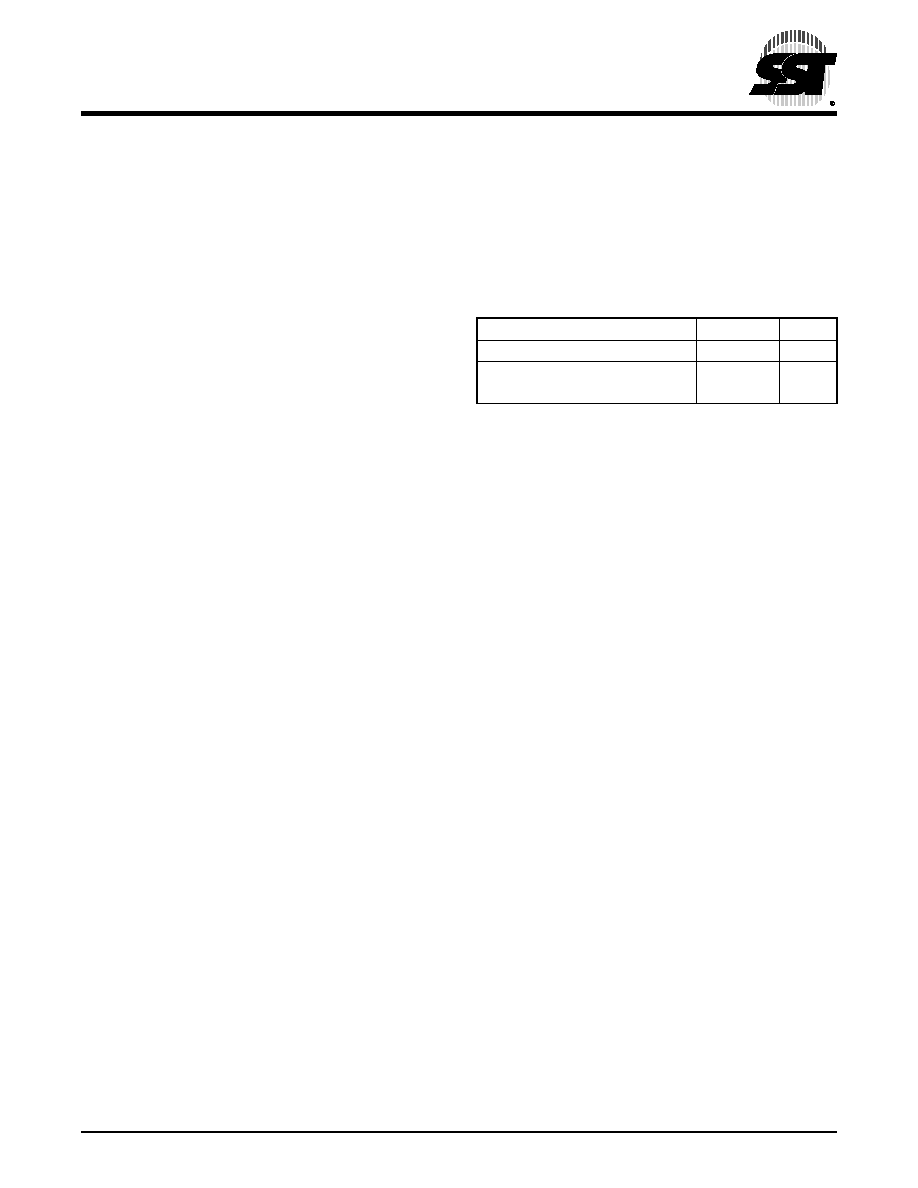
©2003 Silicon Storage Technology, Inc.
S71217-03-000
9/03
1
The SST logo and SuperFlash are registered trademarks of Silicon Storage Technology, Inc. Intel is a registered trademark of Intel Corporation.
CSF and ComboMemory are trademarks of Silicon Storage Technology, Inc.
These specifications are subject to change without notice.
Data Sheet
FEATURES:
∑
Flash Organization: 1M x16
∑
Dual-Bank Architecture for Concurrent
Read/Write Operation
≠ 16 Mbit: 12 Mbit + 4 Mbit
∑
SRAM Organization:
≠ 2 Mbit: 128K x16
≠ 4 Mbit: 256K x16
≠ 8 Mbit: 512K x16
∑
Single 2.7-3.3V Read and Write Operations
∑
Superior Reliability
≠ Endurance: 100,000 Cycles (typical)
≠ Greater than 100 years Data Retention
∑
Low Power Consumption:
≠ Active Current: 25 mA (typical)
≠ Standby Current: 20 µA (typical)
∑
Hardware Sector Protection (WP#)
≠ Protects 4 outer most sectors (4 KWord) in the
larger bank by holding WP# low and unprotects
by holding WP# high
∑
Hardware Reset Pin (RST#)
≠ Resets the internal state machine to reading
data array
∑
Sector-Erase Capability
≠ Uniform 1 KWord sectors
∑
Block-Erase Capability
≠ Uniform 32 KWord blocks
∑
Read Access Time
≠ Flash: 70 ns
≠ SRAM: 70 ns
∑
Latched Address and Data
∑
Fast Erase and Word-Program:
≠ Sector-Erase Time: 18 ms (typical)
≠ Block-Erase Time: 18 ms (typical)
≠ Chip-Erase Time: 70 ms (typical)
≠ Word-Program Time: 14 µs (typical)
≠ Chip Rewrite Time: 8 seconds (typical)
∑
Automatic Write Timing
≠ Internal
V
PP
Generation
∑
End-of-Write Detection
≠ Toggle Bit
≠ Data# Polling
≠ Ready/Busy# pin
∑
CMOS I/O Compatibility
∑
JEDEC Standard Command Set
∑
Conforms to Common Flash Memory Interface
(CFI)
∑
Packages Available
≠ 56-ball LFBGA (8mm x 10mm)
≠ 62-ball LFBGA (8mm x 10mm)
PRODUCT DESCRIPTION
The SST34HF16x1A and SST34HF1681 ComboMemory
devices integrate a 1M x16 CMOS flash memory bank with
either a 128K x16, 256K x16, or 512K x16 CMOS SRAM
memory bank in a multi-chip package (MCP). These devices
are fabricated using SST's proprietary, high-performance
CMOS SuperFlash technology incorporating the split-gate
cell design and thick oxide tunneling injector to attain better
reliability and manufacturability compared with alternate
approaches. The SST34HF16x1A and SST34HF1681
devices are ideal for applications such as cellular phones,
GPS devices, PDAs, and other portable electronic devices in
a low power and small form factor system.
The SST34HF16x1A and SST34HF1681 feature dual
flash memory bank architecture allowing for concurrent
operations between the two flash memory banks and the
SRAM. The devices can read data from either bank while
an Erase or Program operation is in progress in the oppo-
site bank. The two flash memory banks are partitioned into
4 Mbit and 12 Mbit with bottom sector protection options for
storing boot code, program code, configuration/parameter
data and user data.
The SuperFlash technology provides fixed Erase and Pro-
gram times, independent of the number of Erase/Program
cycles that have occurred. Therefore, the system software
or hardware does not have to be modified or de-rated as is
necessary with alternative flash technologies, whose Erase
and Program times increase with accumulated Erase/Pro-
gram cycles. The SST34HF16x1A and SST34HF1681
devices offer a guaranteed endurance of 10,000 cycles.
Data retention is rated at greater than 100 years. With high
performance Word-Program, the flash memory banks pro-
vide a typical Word-Program time of 14 µsec. The entire
flash memory bank can be erased and programmed word-
by-word in typically 8 seconds for the SST34HF16x1A and
SST34HF1681, when using interface features such as Tog-
gle Bit or Data# Polling to indicate the completion of Pro-
gram operation. To protect against inadvertent flash write,
the SST34HF16x1A and SST34HF1681 devices contain
on-chip hardware and software data protection schemes.
16 Mbit Concurrent SuperFlash + 2/4/8 Mbit SRAM ComboMemory
SST34HF1621A / SST34HF1641A / SST34HF1681
SST34HF168116Mb CSF (x16) + 2/4/8 Mb SRAM (x16) MCP ComboMemory

2
Data Sheet
16 Mbit Concurrent SuperFlash + 2/4/8 Mbit SRAM ComboMemory
SST34HF1621A / SST34HF1641A / SST34HF1681
©2003 Silicon Storage Technology, Inc.
S71217-03-000
9/03
The flash and SRAM operate as two independent memory
banks with respective bank enable signals. The memory
bank selection is done by two bank enable signals. The
SRAM bank enable signals, BES1# and BES2, select the
SRAM bank. The flash memory bank enable signal, BEF#,
has to be used with Software Data Protection (SDP) com-
mand sequence when controlling the Erase and Program
operations in the flash memory bank. The memory banks
are superimposed in the same memory address space
where they share common address lines, data lines, WE#
and OE# which minimize power consumption and area.
Designed, manufactured, and tested for applications requir-
ing low power and small form factor, the SST34HF16x1A
and SST34HF1681 are offered in both commercial and
extended temperatures and a small footprint package to
meet board space constraint requirements.
Device Operation
The SST34HF16x1A and SST34HF1681 uses BES1#,
BES2 and BEF# to control operation of either the flash or
the SRAM memory bank. When BEF# is low, the flash
bank is activated for Read, Program or Erase operation.
When BES1# is low, and BES2 is high the SRAM is acti-
vated for Read and Write operation. BEF# and BES1# can-
not be at low level, and BES2 cannot be at high level at the
same time. If all bank enable signals are asserted, bus
contention will result and the device may suffer perma-
nent damage. All address, data, and control lines are
shared by flash and SRAM memory banks which mini-
mizes power consumption and loading. The device goes
into standby when BEF# and BES1# bank enables are
raised to V
IHC
(Logic High) or when BEF# is high and
BES2 is low.
Concurrent Read/Write Operation
Dual bank architecture of SST34HF16x1A and
SST34HF1681 devices allows the Concurrent Read/Write
operation whereby the user can read from one bank while
program or erase in the other bank. This operation can be
used when the user needs to read system code in one
bank while updating data in the other bank. See Figure 1
for Dual-Bank Memory Organization.
Note: For the purposes of this table, write means to Block-, Sector,
or Chip-Erase, or Word-Program as applicable to the appro-
priate bank.
Flash Read Operation
The Read operation of the SST34HF16x1A and
SST34HF1681 is controlled by BEF# and OE#, both have
to be low for the system to obtain data from the outputs.
BEF# is used for device selection. When BEF# is high, the
chip is deselected and only standby power is consumed.
OE# is the output control and is used to gate data from the
output pins. The data bus is in high impedance state when
either BEF# or OE# is high. Refer to the Read cycle timing
diagram for further details (Figure 7).
C
ONCURRENT
R
EAD
/W
RITE
S
TATES
Flash
SRAM
Bank 1
Bank 2
Read
Write
No Operation
Write
Read
No Operation
Write
No Operation
Read
No Operation
Write
Read
Write
No Operation
Write
No Operation
Write
Write

Data Sheet
16 Mbit Concurrent SuperFlash + 2/4/8 Mbit SRAM ComboMemory
SST34HF1621A / SST34HF1641A / SST34HF1681
3
©2003 Silicon Storage Technology, Inc.
S71217-03-000
9/03
Flash Word-Program Operation
The SST34HF16x1A and SST34HF1681 are programmed
on a word-by-word basis. Before Program operations, the
memory must be erased first. The Program operation con-
sists of three steps. The first step is the three-byte load
sequence for Software Data Protection. The second step is
to load word address and word data. During the Word-Pro-
gram operation, the addresses are latched on the falling
edge of either BEF# or WE#, whichever occurs last. The
data is latched on the rising edge of either BEF# or WE#,
whichever occurs first. The third step is the internal Pro-
gram operation which is initiated after the rising edge of the
fourth WE# or BEF#, whichever occurs first. The Program
operation, once initiated, will be completed typically within
10 µs. See Figures 8 and 9 for WE# and BEF# controlled
Program operation timing diagrams and Figure 22 for flow-
charts. During the Program operation, the only valid reads
are Data# Polling and Toggle Bit. During the internal Pro-
gram operation, the host is free to perform additional tasks.
Any commands issued during the internal Program opera-
tion are ignored.
Flash Sector/Block-Erase Operation
The Sector/Block-Erase operation allows the system to
erase the device on a sector-by-sector or block-by-block
basis. The SST34HF16x1A and SST34HF1681 offer both
Sector-Erase and Block-Erase mode. The sector architec-
ture is based on uniform sector size of 1 KWord. The Block-
Erase mode is based on uniform block size of 32 KWord.
The Sector-Erase operation is initiated by executing a six-
byte command sequence with Sector-Erase command
(30H) and sector address (SA) in the last bus cycle. The
Block-Erase operation is initiated by executing a six-byte
command sequence with Block-Erase command (50H)
and block address (BA) in the last bus cycle. The sector or
block address is latched on the falling edge of the sixth
WE# pulse, while the command (30H or 50H) is latched on
the rising edge of the sixth WE# pulse. The internal Erase
operation begins after the sixth WE# pulse. See Figures 13
and 14 for timing waveforms. Any commands issued during
the Sector- or Block-Erase operation are ignored.
Flash Chip-Erase Operation
The SST34HF16x1A and SST34HF1681 provide a Chip-
Erase operation, which allows the user to erase all unpro-
tected sectors/blocks to the "1" state. This is useful when
the device must be quickly erased.
The Chip-Erase operation is initiated by executing a six-
byte command sequence with Chip-Erase command (10H)
at address 5555H in the last byte sequence. The Erase
operation begins with the rising edge of the sixth WE# or
BEF#, whichever occurs first. During the Erase operation,
the only valid read is Toggle Bits or Data# Polling. See
Table 4 for the command sequence, Figure 12 for timing
diagram, and Figure 25 for the flowchart. Any commands
issued during the Chip-Erase operation are ignored.
Flash Write Operation Status Detection
The SST34HF16x1A and SST34HF1681 provide one
hardware and two software means to detect the comple-
tion of a Write (Program or Erase) cycle, in order to opti-
mize the system Write cycle time. The hardware
detection uses the Ready/Busy# (RY/BY#) pin. The soft-
ware detection includes two status bits: Data# Polling
(DQ
7
) and Toggle Bit (DQ
6
). The End-of-Write detection
mode is enabled after the rising edge of WE#, which ini-
tiates the internal Program or Erase operation.
The actual completion of the nonvolatile write is asynchro-
nous with the system; therefore, either a Ready/Busy# (RY/
BY#), Data# Polling (DQ
7
) or Toggle Bit (DQ
6
) read may be
simultaneous with the completion of the Write cycle. If this
occurs, the system may possibly get an erroneous result,
i.e., valid data may appear to conflict with either DQ
7
or
DQ
6
. In order to prevent spurious rejection, if an erroneous
result occurs, the software routine should include a loop to
read the accessed location an additional two (2) times. If
both reads are valid, then the device has completed the
Write cycle, otherwise the rejection is valid.

4
Data Sheet
16 Mbit Concurrent SuperFlash + 2/4/8 Mbit SRAM ComboMemory
SST34HF1621A / SST34HF1641A / SST34HF1681
©2003 Silicon Storage Technology, Inc.
S71217-03-000
9/03
Ready/Busy# (RY/BY#)
The SST34HF16x1A and SST34HF1681 include a Ready/
Busy# (RY/BY#) output signal. During any SDP initiated
operation, e.g., Erase, Program, CFI or ID Read operation,
RY/BY# is actively pulled low, indicating a SDP controlled
operation is in Progress. The status of RY/BY# is valid after
the rising edge of fourth WE# (or BEF#) pulse for Program
operation. For Sector-, Block- or Bank-Erase, the RY/BY#
is valid after the rising edge of sixth WE# or (BEF#) pulse.
RY/BY# is an open drain output that allows several devices
to be tied in parallel to V
DD
via an external pull up resistor.
Ready/Busy# is in high impedance whenever OE# or
BEF# is high or RST# is low. There is a 1 µs bus recovery
time (T
BR
) required before valid data can be read on the
data bus. New commands can be entered immediately
after RY/BY# goes high.
Flash Data# Polling (DQ
7
)
When the SST34HF16x1A and SST34HF1681 are in the
internal Program operation, any attempt to read DQ
7
will
produce the complement of the true data. Once the Pro-
gram operation is completed, DQ
7
will produce true data.
Note that even though DQ
7
may have valid data immedi-
ately following the completion of an internal Write opera-
tion, the remaining data outputs may still be invalid: valid
data on the entire data bus will appear in subsequent suc-
cessive Read cycles. During internal Erase operation, any
attempt to read DQ
7
will produce a `0'. Once the internal
Erase operation is completed, DQ
7
will produce a `1'. The
Data# Polling (DQ
7
) is valid after the rising edge of fourth
WE# (or BEF#) pulse for Program operation. For Sector-,
Block- or Chip-Erase, the Data# Polling (DQ
7
) is valid after
the rising edge of sixth WE# (or BEF#) pulse. See Figure
10 for Data# Polling (DQ
7
) timing diagram and Figure 23 for
a flowchart. There is a 1 µs bus recovery time (T
BR
)
required before valid data can be read on the data bus.
New commands can be entered immediately after DQ
7
becomes true data.
Flash Toggle Bits (DQ
6
)
During the internal Program or Erase operation, any con-
secutive attempts to read DQ
6
will produce alternating 1s
and 0s, i.e., toggling between 1 and 0. When the internal
Program or Erase operation is completed, the DQ
6
bit will
stop toggling. The device is then ready for the next oper-
ation. The Toggle Bit (DQ
6
) is valid after the rising edge
of fourth WE# (or BEF#) pulse for Program operation.
For Sector-, Block- or Chip-Erase, the Toggle Bit (DQ
6
) is
valid after the rising edge of sixth WE# (or BEF#) pulse.
See Figure 11 for Toggle Bit timing diagram and Figure
23 for a flowchart. There is a 1 µs bus recovery time (T
BR
)
required before valid data can be read on the data bus.
New commands can be entered immediately after DQ
6
no
longer toggles.
Data Protection
The SST34HF16x1A and SST34HF1681 provide both
hardware and software features to protect nonvolatile data
from inadvertent writes.
Hardware Data Protection
Noise/Glitch Protection: A WE# or BEF# pulse of less than
5 ns will not initiate a Write cycle.
V
DD
Power Up/Down Detection: The Write operation is
inhibited when V
DD
is less than 1.5V.
Write Inhibit Mode: Forcing OE# low, BEF# high, or WE#
high will inhibit the Write operation. This prevents inadvert-
ent writes during power-up or power-down.
Hardware Block Protection
The SST34HF16x1A and SST34HF1681 provide a hard-
ware block protection which protects the outermost 4
KWord in Bank 1. The block is protected when WP# is held
low. See Figure 1 for Block-Protection location.
A user can disable block protection by driving WP# high
thus allowing erase or program of data into the protected
sectors. WP# must be held high prior to issuing the write
command and remain stable until after the entire Write
operation has completed.

Data Sheet
16 Mbit Concurrent SuperFlash + 2/4/8 Mbit SRAM ComboMemory
SST34HF1621A / SST34HF1641A / SST34HF1681
5
©2003 Silicon Storage Technology, Inc.
S71217-03-000
9/03
Hardware Reset (RST#)
The RST# pin provides a hardware method of resetting the
device to read array data. When the RST# pin is held low
for at least T
RP,
any in-progress operation will terminate and
return to Read mode (see Figure 19). When no internal
Program/Erase operation is in progress, a minimum period
of T
RHR
is required after RST# is driven high before a valid
Read can take place (see Figure 18).
The Erase operation that has been interrupted needs to be
reinitiated after the device resumes normal operation mode
to ensure data integrity. See Figures 18 and 19 for timing
diagrams.
Software Data Protection (SDP)
The SST34HF16x1A and SST34HF1681 provide the
JEDEC standard Software Data Protection scheme for all
data alteration operations, i.e., Program and Erase. Any
Program operation requires the inclusion of the three-byte
sequence. The three-byte load sequence is used to initiate
the Program operation, providing optimal protection from
inadvertent Write operations, e.g., during the system
power-up or power-down. Any Erase operation requires the
inclusion of six-byte sequence. The SST34HF16x1A and
SST34HF1681 are shipped with the Software Data Protec-
tion permanently enabled. See Table 4 for the specific soft-
ware command codes. During SDP command sequence,
invalid commands will abort the device to Read mode
within T
RC.
The contents of DQ
15
-DQ
8
are "Don't Care"
during any SDP command sequence.
Common Flash Memory Interface (CFI)
The SST34HF16x1A and SST34HF1681 also contain the
CFI information to describe the characteristics of the device.
In order to enter the CFI Query mode, the system must
write three-byte sequence, same as Software ID Entry com-
mand with 98H (CFI Query command) to address 555H in
the last byte sequence. Once the device enters the CFI
Query mode, the system can read CFI data at the
addresses given in Tables 5 through 7. The system must
write the CFI Exit command to return to Read mode from
the CFI Query mode.
Product Identification
The Product Identification mode identifies the device as the
SST34HF16x1A or SST34HF1681 and manufacturer as
SST. This mode may be accessed by software operations
only. The hardware device ID Read operation, which is typ-
ically used by programmers cannot be used on this device
because of the shared lines between flash and SRAM in
the multi-chip package. Therefore, application of high volt-
age to pin A
9
may damage this device. Users may use the
software Product Identification operation to identify the part
(i.e., using the device ID) when using multiple manufactur-
ers in the same socket. For details, see Tables 3 and 4 for
software operation, Figure 15 for the Software ID Entry and
Read timing diagram and Figure 24 for the ID Entry com-
mand sequence flowchart.
Product Identification Mode Exit/
CFI Mode Exit
In order to return to the standard Read mode, the Software
Product Identification mode must be exited. Exit is accom-
plished by issuing the Software ID Exit command
sequence, which returns the device to the Read mode.
This command may also be used to reset the device to the
Read mode after any inadvertent transient condition that
apparently causes the device to behave abnormally, e.g.,
not read correctly. Please note that the Software ID Exit/
CFI Exit command is ignored during an internal Program or
Erase operation. See Table 4 for software command
codes, Figure 17 for timing waveform and Figure 24 for a
flowchart.
SRAM Operation
With BES1# low, BES2 and BEF# high, the
SST34HF16x1A and SST34HF1681 operate as either
128K x16, 256K x16, or 512K x16 CMOS SRAM, with
fully static operation requiring no external clocks or timing
strobes. The SST34HF16x1A and SST34HF1681 SRAM
is mapped into the first 512 KWord address space. When
BES1#, BEF# are high and BES2 is low, all memory
banks are deselected and the device enters standby.
Read and Write cycle times are equal. The control sig-
nals UBS# and LBS# provide access to the upper data
byte and lower data byte. See Table 3 for SRAM Read
and Write data byte control modes of operation.
TABLE
1: P
RODUCT
I
DENTIFICATION
ADDRESS
DATA
Manufacturer's ID
0000H
00BFH
Device ID
SST34HF1621A/1641A/1681
0001H
2761H
T1.0 1217




